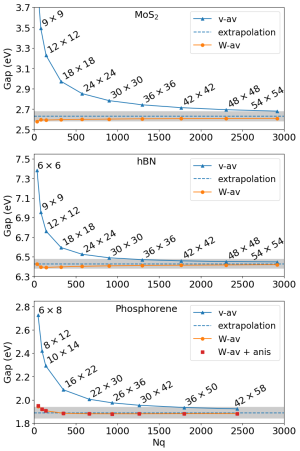Accelerating GW in 2D systems
Since Yambo v5.1 it is possible to use an algorithm able to accelerate convergences of GW calculations in two-dimensional systems with respect to the k point sampling.
The method is explained in the paper:
Efficient GW calculations in two-dimensional materials through a stochastic integration of the screened potential
A. Guandalini, P. D'Amico, A. Ferretti and D. Varsano
available at the link: https://doi.org/10.1038/s41524-023-00989-7
The method makes use of a truncated Coulomb potential in a slab geometry that in Fourier space reads:
[math]\displaystyle{ V_G(q)=\frac{4\pi}{\vert q+G \vert^2}[1-e^{-\vert q_\parallel+G_\parallel\vert L/2}cos[(q_z+G_z)L/2)] }[/math]
where L is the length of the cell in the non-periodic z direction. As the q-grid is 2D, we have [math]\displaystyle{ q_z = 0. }[/math]
To activate the algorithm it is needed to add the RIM_W in your GW input file:

rim_cut # [R] Coulomb potential HF_and_locXC # [R] Hartree-Fock gw0 # [R] GW approximation ppa # [R][Xp] Plasmon Pole Approximation for the Screened Interaction dyson # [R] Dyson Equation solver em1d # [R][X] Dynamically Screened Interaction RIM_W # Activate the RIM_W algorithm
and set the "slab z" Coulomb cutoff:
CUTGeo= "slab z" # [CUT] Coulomb Cutoff geometry: box/cylinder/sphere/ws/slab X/Y/Z/XY..
where z is the non periodic direction.
and finally define the variable governing the Monte Carlo integration e.g.:
RandQpts=3000000 # [RIM] Number of random q-points in the BZ RandGvec= 97 RL # [RIM] Coulomb interaction RS components RandGvecW = 15 RL
here RandGvecW defines the number of G vectors to integrate W outside the BZ.